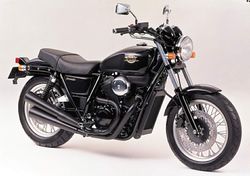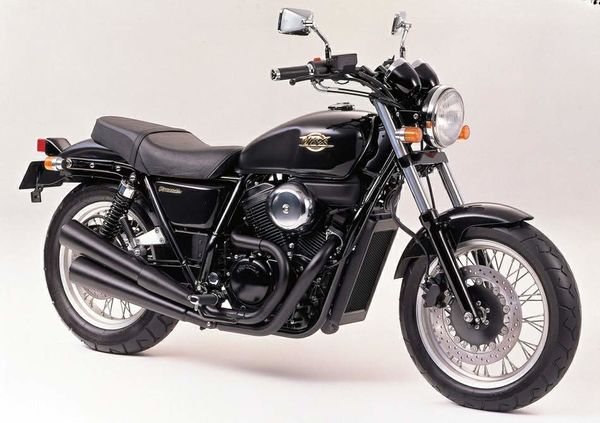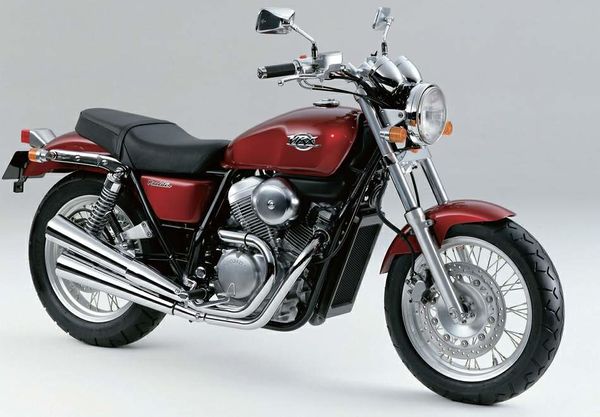Honda VRX400 Roadster
 |
|
| Honda VRX400 Roadster | |
| Manufacturer | |
|---|---|
| Production | 1995-96 |
| Engine | Four stroke, V-twin, OHC |
| Compression ratio | 9,8:1 |
| Ignition | Transisto |
| Transmission | 5 Speed |
| Suspension | Front: Telescopic forks Rear: Swinging arm |
| Brakes | Front: Single disc Rear: Single disc |
| Front Tire | 120/80 -17 |
| Rear Tire | 140/80-17 |
| Weight | 190 kg (dry), |
| Recommended Oil | Honda GN4 10W-40 |
| Fuel Capacity | 11 Liters |
| Manuals | Service Manual |
Engine[edit | edit source]
The engine was a Air cooled cooled Four stroke, V-twin, OHC. The engine featured a 9,8:1 compression ratio.
Chassis[edit | edit source]
It came with a 120/80 -17 front tire and a 140/80-17 rear tire. Stopping was achieved via Single disc in the front and a Single disc in the rear. The front suspension was a Telescopic forks while the rear was equipped with a Swinging arm. The VRX400 Roadster was fitted with a 11 Liters fuel tank. The bike weighed just 190 kg.
Photos[edit | edit source]
Overview[edit | edit source]
Honda VRX400 Roadster
The '95 Honda VRX400 is, spiritually at least, a cross between traditional Japanese roadster, such as the 400 Bandit, and the classic Harley-Davidson Sportster.
At its heart is a air-cooled V-twin from the in Asia popular Honda Steed 400 Custom. But, Honda being Honda, it has re-engineered the mill in a bid to create more character - in a similar way to when it redesigned its VT1100 Shadow Ace to emulate classic Hogs.
At low revs it's rough and tough, with both bar-ends visibly shaking, but is also respectable torque for a 400cc. Then, in the midrange, the V-twin pulses smooth out to develop regular and smooth power all the way to 8000rpm. According to Honda, irregular, or plain lack of vibration can induce tedium of fatigue, and the VRX's deliberately engineered pulses are, it claims at the time, more comfortable and relaxing, in the same way as birds singing, waves, winds and the human pulse.
At a steady 80km/h, the VRX is supposed to produce this same Utopian good vibe. I couldn't detect this but the Honda VRX is certainly a relaxing '95 bike.
The riding position also falls between an American custom and a retro. Despite squashed knees, I found it comfortable, especially the way my back was held straight and my arms were spread by the low, wide bars. It feels very natural.
Riding the Honda VRX400 in Bangkok is fun. Its slight dimensions made splitting the endless traffic jams easy, and out in the country it handles more like a Honda CBR400 than a semi-custom. The VRX400 may look dated but it is just the retro look, the cycle parts are what you can expect from a 13-year-old model bike, the steering is responsive and you feel in control.
The Honda VRX400 was officially only introduced in Japanese market, and like many Japanese-market bikes the fork and twin shocks are set soft but the chassis overall is sufficiently taut and vice-free.
Driving the bike for a weekend in downtown Bangkok made me truly happy, even the bikes exhaust cooked my right foot at a standstill.
Source
| Make Model | Honda VRX 400 Roadster |
|---|---|
| Year | 1995-96 |
| Engine Type | Four stroke, V-twin, OHC |
| Displacement | 398 cc / |
| Bore X Stroke | 64 x 62 mm |
| Cooling System | Air cooled |
| Compression | 9,8:1 |
| Induction | 32mm VDD0 |
| Ignition | Transisto |
| Starting | Electric |
| Max Power | |
| Max Torque | |
| Transmission | 5 Speed |
| Final Drive | Chain |
| Front Suspension | Telescopic forks |
| Rear Suspension | Swinging arm |
| Front Brakes | Single disc |
| Rear Brakes | Single disc |
| Front Tire | 120/80 -17 |
| Rear Tire | 140/80-17 |
| Dry Weight | 190 kg |
| Fuel Capacity | 11 Liters |

